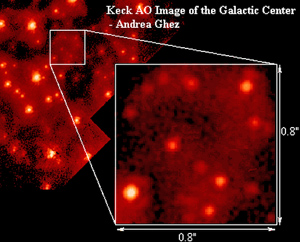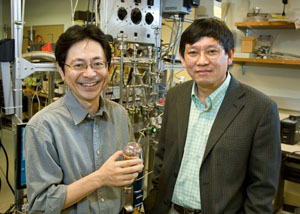Astronomy and Astrophysics

UCLA offers a number of specialties in this field. Astronomy and astrophysics researchers cover topics such as stellar astronomy, involving studies at the galactic center, star evolution, planet formation. In cosmology our faculty study active galactic nuclei and quasars, infrared astronomy, and Hubble telescope imagery.
UCLA is a major partner in the new National Science Foundation Science and Technology Center For Adaptive Optics. The center, led by U.C. Santa Cruz Professor Jerry Nelson, brings adaptive optics to its full potential both in the field of astronomy and vision science.
Three UCLA astronomy professors (Andrea Ghez, James Larkin and Ian McLean) are leading major programs within the AO Center (CfAO for short). Andrea Ghez is also the Associate Director for Astronomical Science and James Larkin is the Associate Director for Scientific Instrumentation.
Extragalactic studies involves determining the nature of active galactic nuclei and quasars, the dynamics and statistics of galaxy clusters, star formation, infrared spectroscopy and diffraction limited imaging to study nearby active galaxies, star-formation and metal-enrichment histories of galaxies, and the development of galaxy structure.
UCLA has also been involved in the use of infrared astronomy. Spurred by the development of tiny, solid-state imaging devices called infrared arrays, infrared astronomy has undergone a revolution. Astronomers can now obtain electronic images of stars too cool to emit much normal light or too heavily enshrouded in gas and dust for normal light to escape. Moreover, with the advent of adaptive optics, infrared images can now be obtained at the diffraction limit of the Keck 10-m telescope thus revealing exquisite detail in these hidden regions.
Astroparticle Physics

UCLA has built a strong and very active group in astrophysics. Comprising ten faculty members and more than forty researchers overall, the group is involved in experimental and theoretical research in the areas of dark matter, high-energy astrophysics (using gamma rays, cosmic rays and neutrinos), and cosmology.
The research carried out in astroparticle physics at UCLA is at the interface between, and is closely connected to, research in the areas of experimental elementary particle physics (EEP), theoretical elementary particle physics (TEP), and astronomy.
Our Astrophysics group specializes in a number of interconnected areas of interest. Some areas of research: investigating the origin of the universe, connecting the world of elementary particles with cosmology and astrophysics, dark matter, the physics of neutrinos, gamma rays and cosmic backgrounds, high energy collider physics, and the structure of the universe.

UCLA's astrophysics researchers have also been particle detectors such as the Hadron Collider Experiment and the Compact Muon Solenoid studies at CERN, the ICARUS dark matter experiment at Gran Sasso in Italy, the ground-based VERITAS experiment studying gamma-rays, and ANITA, searching for ultra-high energy cosmic neutrinos in Antarctic ice.
Faculty are also involved in studying the possible existence of a mass for the cosmologically interesting mu or tau neutrinos and methods to detect this mass using terrestrial solar or supernova neutrino sources.